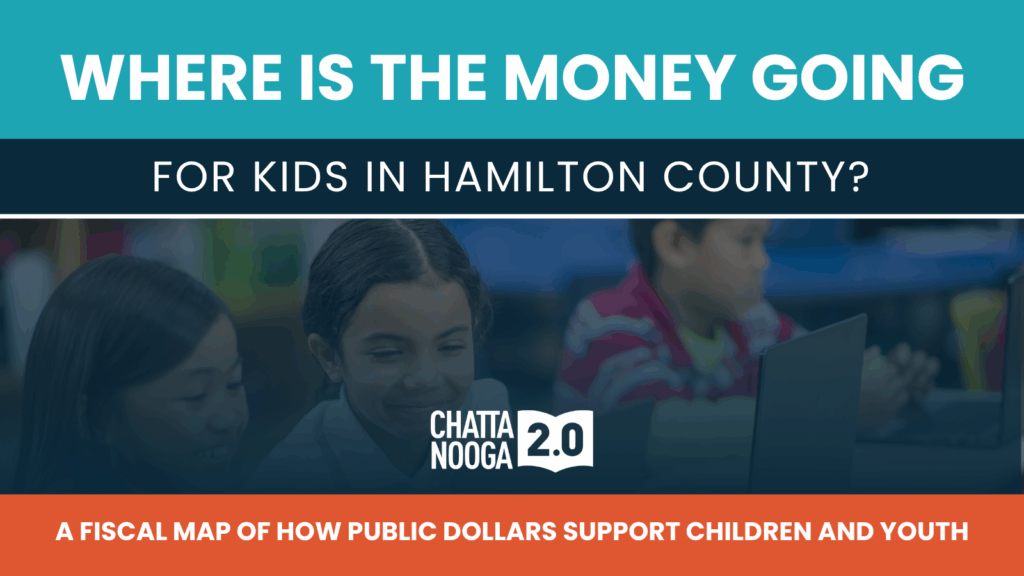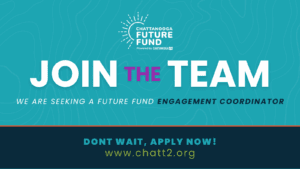Chattanooga 2.0 launches an interactive tool that allows the community to explore how public investments benefit children in Hamilton County, TN.
Access the new Children and Youth Fiscal Map Here
Ever wondered how our local governments, the state, and the nation invest in Hamilton County kids?
Despite the name, you won’t find any landmarks on this “map”. Fiscal maps visually represent the flow and allocation of financial resources. The map represents financial streams, making it easier to understand complex funding structures and identify potential gaps or overlaps.
Over the last year, Chattanooga 2.0 and our partners have developed a children and youth fiscal map to better understand how public funds are being spent on children and their families in Hamilton County. This interactive tool brings together funding data from multiple public sources across sectors, including health, education, and family support services to provide a comprehensive snapshot of spending on children and youth in our community.
We have made every effort to be as comprehensive as possible, but there may be some funding streams that are not included due to data availability or reporting limitations. The data in this fiscal map reflects actual expenditures from a range of sources with public school district funds making up the bulk of spending for youth ages 5-17. Because the fiscal year runs from July 1 to June 30, this data lags by several months. The map will be updated at the end of the calendar year once the school district books are closed for FY25. If you would like more information on the current budgets check out FY2025 and FY2026.
The map contains a large amount of funding data. Users can explore how dollars are allocated, identify funding gaps, and understand which programs are supported by local, state, or federal funds. The map is broken down in a variety of ways, including by eligible services and programs, with or without Hamilton County Schools funding, by funding level, by age, and much more. If you want to deep dive into the school district funds check out the ‘School District Expenses’ page, or if you’re curious about how funding is spent by age, check out the ‘Age Analysis’ page.
Why do we need a fiscal map?
Chattanooga 2.0 and our community partners are committed to ensuring every child in Hamilton County has access to the resources they need to thrive. To reach that goal, we must understand how our community is already investing in kids and where gaps remain. This fiscal map gives us that visibility.
By pulling together local, state, and federal data into one place, the fiscal map will help:
- Inform strategic funding decisions.
- Identify potential duplication or service gaps.
- Support grant writing and organizational planning for community partners.
- Bring transparency to how early resources are being used for children and youth.
- Support advocacy for sustained and increased investments where needed.
As federal pandemic relief funds expire, local leaders are grappling with how to maintain and grow supports for children and youth. This map helps decision-makers understand where funds are flowing.
What are the key takeaways?
Several key findings have emerged from the 2023-2024 fiscal map:
Big Picture
- Local and state funds make up the majority of funding for children and youth in Hamilton County when school district funding is included. In 2023, for every $1 invested in children (through local and state sources), Hamilton County received $0.52 in federal support. In 2024, that figure decreased to $0.36.
- From 2023 to 2024, there was a large increase in state funding mostly due to the transition to the new state funding formula known as TISA (Tennessee Investment in Student Achievement).
- Spending per child decreased by 34% for children under age 5, primarily due to the expiration of American Rescue Plan Act (ARPA) relief funds. In contrast, spending per child increased by 15% for children ages 5-17 driven by the switch to TISA.
- K-12 education remains the primary area of investment for children and youth. When public school funds are excluded, the majority of dollars spent on children and youth in Hamilton County come from federal sources.
Early Childhood
- There was a significant decrease in funding from 2023 to 2024 for children under 5 years old due to the end of ARPA funds. In 2023, Hamilton County spent $101M on programs and services for children under 5 compared to only $67M in 2024. Some of these expiring funds included the ARPA childcare stabilization grants and ARPA IDEA Part B funds, which benefited students with disabilities.
- The majority of funds spent on children under age 5 were federal funds, such as the Child Care and Development Block Grant (which funds Families First child care tuition subsidies for income-eligible families as well as quality improvement through Child Care Resource & Referral), Head Start, and the Supplemental Nutrition Assistance Program (SNAP). The total federal funds (including pandemic relief dollars) invested in children amounted to $88M in 2023, decreasing to $53M in 2024.
- In 2023, for every $1 the federal government invested in Hamilton County to benefit children under age 5, the state of TN invested $0.12. This increased to $0.22 in 2024, not because the state invested more but because federal funding decreased due to expiring ARPA funds.
Out-of-School-Time Sector
- Even though 80% of children’s waking hours are spent outside of school each year, we are spending very little in the out-of-school time sector to support our children and youth. Less than 1% of public funding included on this fiscal map supports out-of- school time programming for school-age children and youth.
- To explore funding for the out-of-school-time sector, select filter checkboxes for Mentoring, Out of School Time programs, and Recreational Activities on the ‘Services’ page. There was a decrease in spending from 2023 to 2024 in the out-of-school time sector from $2.5M to $444K, mostly due to the sunsetting of federal relief funds*.
*Note below on federal funding for out-of-school time programming.
School-Aged Children
- Total funding across all sectors for children and youth aged 5 to 17 increased from $624 million in 2023 to $719 million in 2024. More than 90% of this funding comes through Hamilton County Schools, with most dollars coming from local and state sources.
- The next largest funding stream for this age group, the Supplemental Nutrition Assistance Program (SNAP), experienced a $4.5M decrease in funding from 2023 to 2024.
Students Pursuing a Postsecondary Education
- Funding for youth ages 18-24 decreased from $17M in 2023 to $12M in 2024 largely due to a decrease in SNAP funds. The majority of these funds are federal funds.
- Funds to support students who are 18-24 include TRIO Upward Bound, GEAR UP, and the City of Chattanooga Internship programs*.
* TN Promise is not included because expenditures are not available by county.
What’s next?
Now that Chattanooga 2.0 has created the fiscal map, the Chattanooga 2.0 Children’s Funding Coordinator will use the map to work with local leaders to strengthen investments in children and youth across the county. The map will help identify opportunities to better align existing resources and advocate for more sustainable funding for children and youth across the county.
This fiscal map is just the beginning. Over the coming months, Chattanooga 2.0 will continue to:
- Refine and expand the dataset, including additional programs and providers.
- Collaborate with state and local agencies to improve data quality and transparency.
- Use this tool to support local budget decisions and community planning.
- Partner with families, educators, and advocates to ensure our youngest residents are prioritized.
While this fiscal map provides insight into funding through the 2024 fiscal year, it is important to acknowledge that federal education funding is already shifting significantly in the current Dfiscal year. For example, the Trump administration recently froze nearly $6.8 billion in federal K–12 grants scheduled for disbursement on July 1, 2025, including funding for afterschool programs, teacher training, migrant student support, and English learner services. This disruption highlights the urgency of understanding different funding streams at the local, state, and federal levels, so our community can strategically anticipate and adapt to fiscal uncertainty that may impact children and youth.
We invite you to explore the map, share your feedback, and join us in making Hamilton County the best place to raise a child.
Questions about the fiscal map? Reach out to rachel@chatt2.org.





